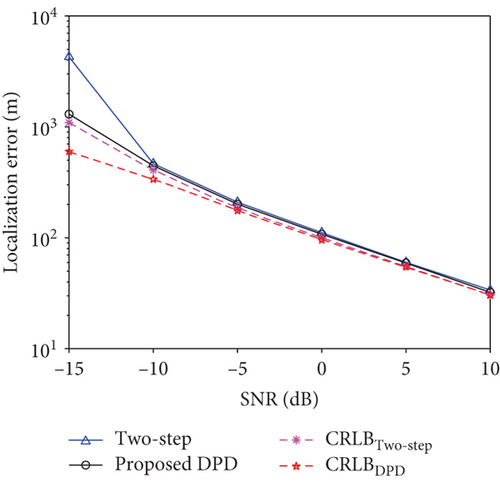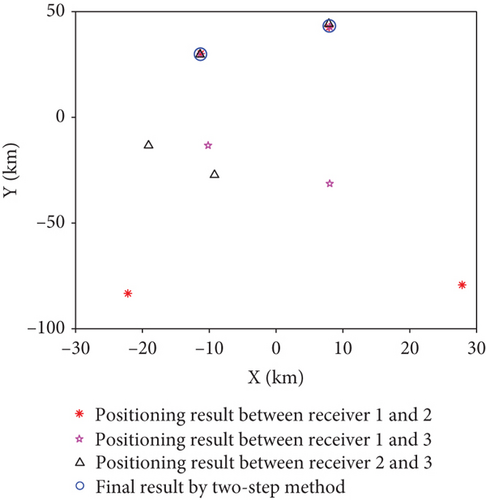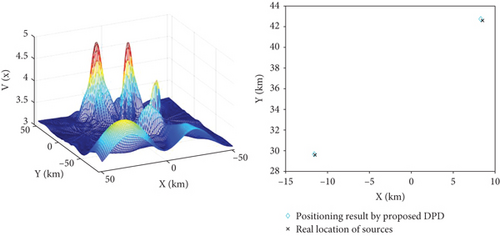Direct Position Determination for Noncooperative Source with Fast Moving Receivers
Abstract
The problem of position estimation for a noncooperative source has always been widely discussed in the field of wireless communication. Direct position determination (DPD) for a noncooperative source with fast moving receivers is discussed in this paper. The sinc function is used to reconstruct the signals, which is an important step in DPD for wideband signals. A DPD method based on the baseband signal is proposed which is more practical in communication signal with high carrier frequency. And based on the proposed DPD method, a DPD method for multiple noncooperative stationary sources by single-channel receivers is presented. In order to evaluate the performance of the proposed DPD method, the Cramér-Rao lower bound (CRLB) for DPD based on baseband signal is derived. Several numerical investigations are carried out to evaluate the performance of the proposed method.
1. Introduction
Noncooperative source localization based on the emitted signals has been of great interest to academic researchers and industrial practitioners for many years [1–5]. The two-step localization method is the most widely used method for traditional source localization. In the first step, the location-related parameters are extracted from the sampled signals. Then, in the second step, the source location is estimated by the extracted parameters. The two-step localization method is usually suboptimal as it ignores the intrinsic constraint that all the extracted parameters should be consistent with the same source location. In addition, in multiple source localization, the two-step method will usually lead to a parameter-to-source association problem, which may require additional efforts.
Motivated by the shortcomings of the two-step method, DPD methods are proposed [6–8] which estimate the source location directly from the received signals without parameter extraction. There is no intermediate parameters to estimate, and the association of the parameters and location of sources are realized implicitly. For a stationary emitter and moving receivers, a common DPD method is to estimate the source location using the signals containing the information of time difference of arrival (TDOA) and frequency difference of arrival (FDOA).
Weiss and Amar [9, 10] proposed a DPD method for the received signals with delay and Doppler, where a downshift matrix was used to model the time delay. The DPD method Weiss and Amar proposed using time-domain modelling [9] and frequency-domain modelling [10] for the received signals. There is a quantization process in the downshift matrix, which leads to the increase of positioning error.
Li et al. [11] improved the downshift matrix by the fast Fourier transform (FFT) method. Lu et al. [12] adopted a similar modelling approach as that in [11], and an iterative algorithm based on particle filter was designed to solve the DPD problem. When the signal bandwidth is narrow, the cumulative time is short or the receivers are moving slowly, the signal model can be established as a narrowband model. When the narrowband condition is not satisfied, it is usually solved by partitioning the received signals into multiple short-time signal segments. When the signal bandwidth is wide, a scaled formulation was used to solve the wideband source localization problems in passive acoustics and sonar applications [13], since significant biases would be introduced if such signals were approximated with narrowband models. The CRLB for wideband DPD is only for random signal in [13]. However, the DPD CRLB for unknown deterministic signal needs to be solved in practical engineering.
Currently, almost all TDOA- and FDOA-based DPD methods assume a stationary source. Most DPD methods only consider narrowband signal, and only consider wideband signal with low carrier frequency such as sonar. Most DPD methods for multiple sources use the signals received by an antenna array [14–19]. Considering the problem of locating multiple noncooperative stationary sources using multiple fast moving receivers with a single antenna, this paper is dedicated to estimating the sources location directly from the received signals. The contributions of the current study are mainly in three aspects. Firstly, a signal baseband reconstruction-based DPD method is proposed which is suitable for wideband signal. Secondly, a DPD method for multiple noncooperative stationary sources is proposed. And finally, the CRLB for DPD method based on baseband signal is derived. Several numerical investigations are carried out to evaluate the performance of the proposed method.
2. Direct Position Determination for Noncooperative Source
2.1. Problem Formulation
Let Λ = [diag(Λ1, ⋯, ΛL)] ⊗ IK, Λl = ηlIM+1, H = diag(H1, ⋯, HK), , Hl,k(m + (M/2) + 1, n + (M/2) + 1) = sinc(bl,km − dl,k − n), m = −M/2, ⋯, −1, 0, 1, ⋯, M/2, n = −M/2, ⋯, −1, 0, 1, ⋯, M/2, , , , , , , , and .
2.2. DPD Based on Baseband Signal
Let , , , , , Ψ = diag(Ψ1, ⋯, ΨK), Ψk = diag(Ψ1,k, ⋯, ΨL,k), , , , , , and .
2.3. DPD for Multiple Sources
By (20), xTp (p = 1, ⋯, P) can be estimated by searching the P local maxima of the objective function V(x) from large to small.
2.4. CRLB for DPD Based on Baseband Signal
When the source signal waveform is unknown, the baseband signal u can be expressed in terms of its real and imaginary parts as . Similarly, can be expressed as . Define the composite unknown vector .
3. Numerical Results
This section conducts several numerical simulations to investigate the proposed method. Two cases are considered in all. The first case is studied to investigate the performance of the DPD method based on the baseband signal from a single source. The second case is studied to investigate the performance of the DPD method for multiple sources.
3.1. Case 1: DPD for Single Source
In this case, the initial positions of the three fast moving receivers are x1(t0) = (30, 5)T (km), x2(t0) = (0, 0)T (km), and x3(t0) = (−30, 5)T (km). The velocities of the three receivers are v1(t0) = (350, 60)T (m/s), v2(t0) = (350, 0)T (m/s), and v3(t0) = (335, 80)T (m/s). The stationary source is located at xT = (8.5, 42.6)T (km). In this case, the source emits signal with BPSK modulation and the bandwidth is 25 kHz. The carrier frequency is set to be f = 303 MHz and the sampling frequency is fs = 100 kHz. 2500 sampling points are collected for source location.
The performance of the proposed DPD method based on baseband signal and the two-step method is evaluated in Figure 1. 100 Monte Carlo simulations are performed at each SNR. In addition, the CRLB of the two-step method CRLBtwo-step and the CRLB of the proposed method CRLBDPD are also presented for comparison. The DPD method outperforms the two-step method especially when SNR is low.

3.2. Case 2: DPD for Multiple Sources
In this case, we consider a scenario for two stationary sources localization where one stationary source is located at xT1 = (8.5, 42.6)T (km) and the other stationary source is located at xT2 = (−11.5, 29.6)T (km). Source 1 and the three moving receivers are present with the same settings as those of case 1 in Section 3.1. Source 2 emits signal with QPSK modulation. The bandwidth and the carrier frequency of the source 2 are the same settings as those of source 1.
In the two-step method, two pairs of time-frequency difference should be extracted by cross-ambiguity function between two receivers, and the time-frequency differences between different receivers cannot be matched. Therefore, each time-frequency difference is used for positioning, respectively. Then, the ambiguity position is existed by two-step method. Therefore, twelve position is located by six pairs of time-frequency differences, as shown in Figure 2(a). When the two sources are far away from each other, two sources can be located by clustering three nearest positioning points, as shown in Figure 2(b).


There is no problems of pairing and ambiguity in the DPD method, so the positions of two sources can be located directly. A single positioning result of DPD is shown in Figure 3, which outperforms the two-step method.

The performance of the proposed DPD method based on baseband signal and the two-step method for multiple sources is evaluated in Figure 4. 100 Monte Carlo simulations are performed at each SNR. The DPD method outperforms the two-step method especially for multiple sources.

4. Conclusion
This paper proposes a DPD method for noncooperative source with fast moving receivers. The proposed method uses the sinc function to reconstruct the signal so that the expansion of the baseband signal caused by the fast moving receivers is also considered. When the carrier frequency is high, only the baseband signal can be used for DPD. So a DPD method based on baseband signal by single-channel receivers is presented. And the proposed DPD method can be used not only for a single source but also for multiple sources. In order to evaluate the performance of the proposed DPD method, the CRLB for DPD based on baseband signal is derived. Simulation results show that the proposed DPD method provides more accurate location estimate than the two-step method.
Conflicts of Interest
The authors declare that they have no conflicts of interest.
Acknowledgments
This work was supported by the National Natural Science Foundation of China (U20B2038).
Appendix
A. Derivation of D
Open Research
Data Availability
No data were used to support this study.




